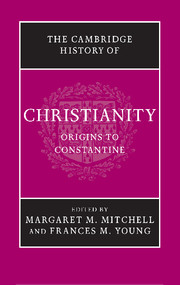Crossref Citations
This Book has been
cited by the following publications. This list is generated based on data provided by Crossref.
Foster, Paul
2007.
Books of the Month.
The Expository Times,
Vol. 118,
Issue. 6,
p.
280.
Shepard, Jonathan
2009.
The Cambridge History of the Byzantine Empire c.500–1492.
Heintz, Michael
2011.
The Encyclopedia of Christian Civilization.
Carleton Paget, James
and
Schaper, Joachim
2013.
The New Cambridge History of the Bible.
Sabo, Theodore
Lioy, Dan
and
Fick, Rikus
2014.
A Hesychasm before Hesychasm.
Journal of Early Christian History,
Vol. 4,
Issue. 1,
p.
88.
2015.
Authority and Performance.
p.
215.
Curran, John
2018.
A Companion to the City of Rome.
p.
541.
Chantin, Jean-Pierre
2018.
De sectes en hérésies.
p.
37.
Rukuni, Rugare
and
Oliver, Erna
2019.
Nicaea as political orthodoxy: Imperial Christianity versus episcopal polities.
HTS Teologiese Studies / Theological Studies,
Vol. 75,
Issue. 4,
Griffis, Michael P.
2019.
Liturgy as Embodied Informal Education for Identity Re-formation: Luther’s 1523 and 1526 Liturgical Reforms.
Christian Education Journal: Research on Educational Ministry,
Vol. 16,
Issue. 2,
p.
202.
Shepard, Jonathan
2019.
The Cambridge History of the Byzantine Empire c.500–1492.
Luff, Rosemary Margaret
2019.
The Impact of Jesus in First-Century Palestine.
Rukuni, Rugare
2020.
Parthian-India and Aksum: A geographical case for pre-Ezana early Christianity in Ethiopia.
HTS Teologiese Studies / Theological Studies,
Vol. 76,
Issue. 4,
van den Heever, Gerhard
2020.
Twilights of Greek and Roman Religions: Afterlives and Transformations—A Response.
Journal of Early Christian History,
Vol. 10,
Issue. 2,
p.
108.
Rukuni, Rugare
2020.
Early Ethiopian Christianity: Retrospective enquiry from the perspective of Indian Thomine tradition.
HTS Teologiese Studies / Theological Studies,
Vol. 76,
Issue. 3,
Rukuni, Rugare
2020.
Religious statecraft: Narratives of persecution and diplomacy in the case of Byzantine, Aksum and Himyar.
HTS Teologiese Studies / Theological Studies,
Vol. 76,
Issue. 1,
Rukuni, Rugare
2021.
Religious statecraft: Narratives of persecution and diplomacy in the case of Byzantine, Aksum and Himyar.
HTS Teologiese Studies / Theological Studies,
Vol. 77,
Issue. 4,
Whitener, Wilson
and
Salter, Alexander William
2022.
Monepiscopacy: A Rational Choice Account.
Journal of Economics, Management and Religion,
Vol. 03,
Issue. 02,
García Marzá, Domingo
and
Calvo, Patrici
2022.
Democracia algorítmica: ¿un nuevo cambio estructural de la opinión pública?.
Isegoría,
p.
e17.
Makgoba, Thabo
2023.
Reflections on episcopal authority.
International Journal for the Study of the Christian Church,
Vol. 23,
Issue. 2,
p.
135.





